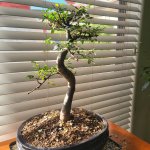Just recently got a Chinese Elm from Eastern leaf. I know little about bonsai and this is only my second tree so I am just looking for some help. As I said I just got the tree and it was shipped from California so probably spent 7 to 10 days in a box being shipped. I assume and hope that is the cause for some leaves falling off and yellowing leaves. I was also wondering I live in Arizona where it gets very hot and hoped that I could keep it inside by a bright window. I also started to notice a white coating on the leaves most of the leaves with the coating were dead or dying. Any advice or information would be greatly appreciated Thanks! 



